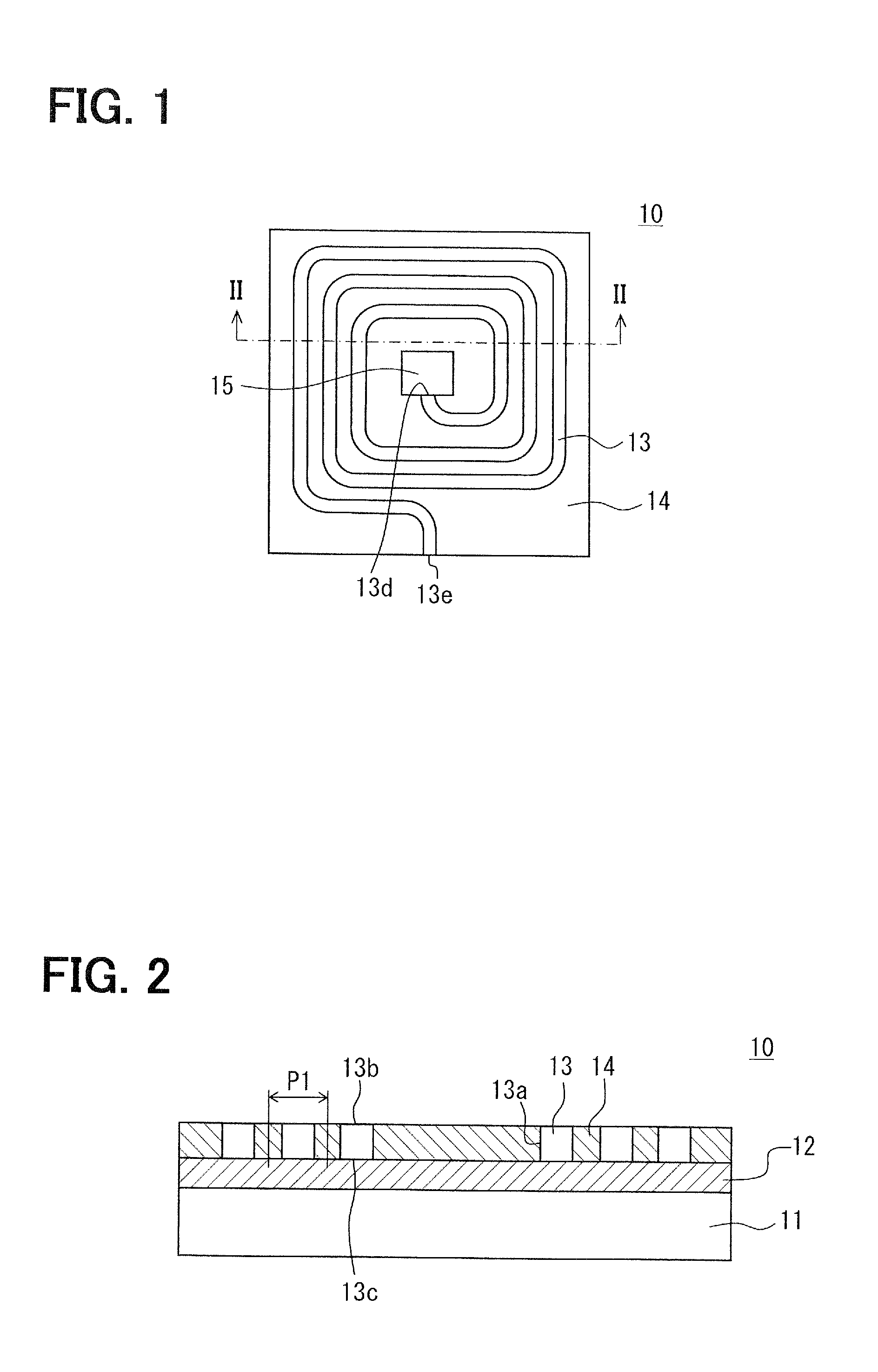Optical waveguide sensor and manufacturing method of the same
- Summary
- Abstract
- Description
- Claims
- Application Information
AI Technical Summary
Benefits of technology
Problems solved by technology
Method used
Image
Examples
first embodiment
[0037]An optical waveguide sensor 10 according to a first embodiment of the present invention will be described with reference to FIG. 1 and FIG. 2.
[0038]The optical waveguide sensor 10 includes a substrate 11 and an optical waveguide formed above the substrate 11. The optical waveguide includes a core 13 and a lateral clad 14. The core 13 extends in a spiral shape above a surface of the substrate 11. The core 13 and the lateral clad 14 are located in the same layer above the surface of the substrate 11. The lateral clad 14 is in contact with either side surfaces 13a of the core 13, and the core 13 is disposed between the lateral clad 14. The core 13 has an upper surface 13b on an opposite side from the substrate 11. A part of the upper surface 13b provides a transmission surface from which an evanescent wave (evanescent light) leaks and is absorbed by a detected object. In the following description, a thickness direction of the substrate 11, that is, a direction perpendicular to th...
second embodiment
[0057]An optical waveguide sensor 10 according to a second embodiment of the present invention will be described with reference to FIG. 4. In the optical waveguide sensor 10 according to the present embodiment, the upper surface 13b and the lower surface 13c of the core 13 function as transmission surfaces. Furthermore, the optical waveguide sensor 10 includes a support layer 16 that restricts buckling of a membrane MEM.
[0058]The optical waveguide sensor 10 shown in FIG. 4 includes a substrate 11 having an upper surface 11a above which a core 13 and a lateral clad 14 are disposed. The substrate 11 has a removed section 17 that opens on the upper surface 11a. Thus, portions of the core 13 and the lateral clad 14 bridging the removed section 17 form the membrane MEM. Not only the upper surface 13b but also the lower surface 13c of the core 13c in the membrane MEM can function as the transmission surfaces.
[0059]In the example shown in FIG. 4, the removed section 17 also opens on a lowe...
third embodiment
[0071]The inventors studied about more preferred configuration in the configurations described in the first embodiment and the second embodiment with simulation. An optical waveguide according to a third embodiment of the present invention is based on the simulation result. In the following simulation, an optical waveguide sensor 10 in which both an upper surface 13b and a lower surface 13c of a core 13 are exposed surfaces as shown in FIG. 8 is used as a model.
[0072]A relationship between a refractive index of the core 13 and a refractive index of a lateral clad 14 according to the present embodiment will be described below. The refractive index of the core 13 is indicated by n1, the refractive index of the lateral clad 14 is indicated by n2 (1), and a difference in refractive index between the core 13 and the lateral clad 13 is indicated by Δn (=n1−n2).
[0073]In FIG. 9, a relationship between the refractive index difference and a normalized transmittivity is shown in a case where a...
PUM
 Login to View More
Login to View More Abstract
Description
Claims
Application Information
 Login to View More
Login to View More - R&D
- Intellectual Property
- Life Sciences
- Materials
- Tech Scout
- Unparalleled Data Quality
- Higher Quality Content
- 60% Fewer Hallucinations
Browse by: Latest US Patents, China's latest patents, Technical Efficacy Thesaurus, Application Domain, Technology Topic, Popular Technical Reports.
© 2025 PatSnap. All rights reserved.Legal|Privacy policy|Modern Slavery Act Transparency Statement|Sitemap|About US| Contact US: help@patsnap.com



